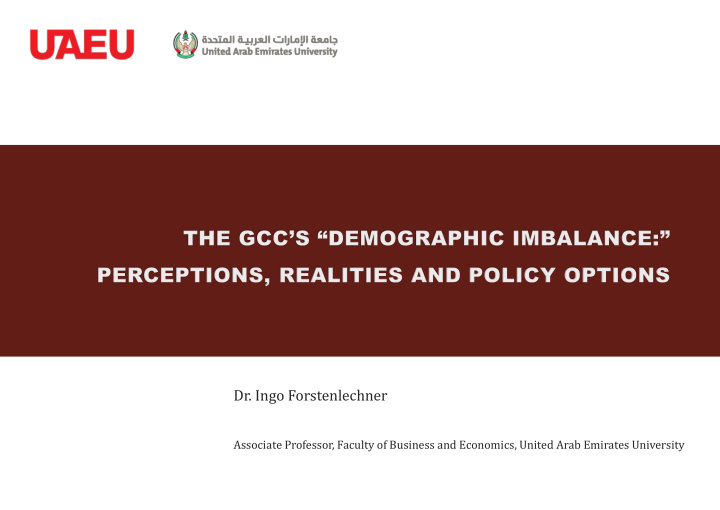



Dr. Ingo Forstenlechner Associate Professor, Faculty of Business and Economics, United Arab Emirates University ‘UAE Productivity Academy: Programs and Institutional Governance’ | Slide 1
• The current demographic situation 1 • Policy responses 2 • Labour market interventions by governments 3 • What may happen next 4
1 2 3 4
• Concerns evolve around loss of culture, loss of economic dominance, and the possible impact on both internal and foreign policy • Overall, a whole range of sociocultural threats • “Demographic time bomb”, the “Gulf’s most dangerous addiction”, etc. • Threat is real in so far as it has been successfully securitized • Looking at the Arab Spring, key demands in the GCC were essentially unemployment pressures (plus discrimination and corruption) 1 2 3 4
TABLE 1 DEMOGRAPHIC IMBALANCES & NATIONAL RESOURCE WEALTH National Resource Wealth a Country 2010 Population (mn) Workforce Oil b Gas c SWF d National Non-national National Non-national Bahrain 0.51 0.54 36.1% 63.9% ... .00037 16,852 Kuwait 1.04 2.43 16.9% 83.1% 0.98 .00173 284,615 Oman 2.39 1.02 28.7% 71.3% 0.02 .00029 3,431 Qatar 0.22 1.46 5.7% 94.3% 1.18 .11500 386,364 Saudi Arabia 20.94 7.75 50.5% 49.5% 0.13 .00038 22,818 UAE 0.95 7.24 4.2% 95.8% 1.03 .00632 759,053 GCC 26.05 20.45 38.3% 61.7% 0.19 .00161 61,313 Notes: a This is per national capita; b In millions of barrels; c In billion cubic metres; d In USD per national capita. Sources: for population: Al Khouri (2010); for the workforce: for Qatar the Qatar Statistics Authority; accessed 2011, for the year 2009, for the UAE authors’ calculations based upon the UAE ’s National Bureau of Statistics labor force figures for 2005 and its most recent 2010 population projection, all others Rutledge (2009) aggregates compiled from official sources between the years 2002 and 2006; for energy reserves: BP Statistical Review (2011); and for estimated value of sovereign wealth under active management: SWF Institute (2011). 1 2 3 4
• No region in the world has higher population growth rates, though only an ever decreasing share is attributable to indigenous birth rates. Birth rates have fallen significantly over the past few decades. • The foreign population growth and the ever growing national unemployment pressures are inseparable issues • Arab Spring might delay necessary reform, but it will happen (e.g. 50.000 new government jobs in Oman, $150bn package in KSA) • Companies in the region have to come to terms with localization, thus far the only tangible benefit is government goodwill • Competition for highly skilled, globally mobile professionals is very real (even China and Russia are in the game) 1 2 3 4
Enhancing educational attainment Upgrade education Diversifying the economy High-tech, high-skill diversification Labour market interventions 1 2 3 4
1 2 3 4
1 2 3 4
• Generally, more pressure to localize • Continued population growth • Increasing cost of labour - one way or another • Streamlining of visa processes (e.g. PPP) • Easing part-time work • Programs to attract and retain the highly skilled • A more gendered approach to the labour market • More and more outsourcing and privatization • Improved educational outcomes • More nuanced approaches to residency 1 2 3 4
• This presentation is mainly based on two articles published in 2010 and 2011: 1. Forstenlechner, I., & Rutledge, E. J. (2011 ). The GCC’s “Demographic Imbalance” : Perceptions, Realities and Policy Options. Middle East Policy, 18 (4), 25-43. 2. Forstenlechner, I., & Rutledge, E. J. (2010). Growing Levels of National Unemployment in the Arab Gulf: Time to Update the 'Social Contract'. Middle East Policy, 17 (2), 38 - 51. • References used for GCC populations statistics 1. Al Khouri, A. (2010). The Challenge of Identity in a Changing World: The Case of GCC Countries . Paper presented at the The 21st-Century Gulf: The Challenge of Identity, Exeter, UK, 30 June - 3 July 2010 2. Rutledge, E. J. (2009). Monetary Union in the Gulf – Prospects for a Single Currency in the Arabian Peninsula . London: Routledge. 3. http://www.swfinstitute.org 4. http://bp.com/statisticalreview
Recommend
More recommend